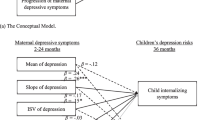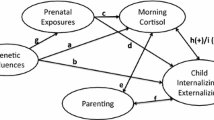Abstract
As a stressful environment in families, mothers’ depressive symptoms might increase children’s risks of developing behavioral problems by exacerbating genetic influences. Using data from the nationally representative Early Childhood Longitudinal Study-Birth Cohort data of approximately 750 pairs of twins, we examined whether genetic influences on preschoolers’ behavioral problems depended upon mothers’ depressive symptoms. Results indicated that the genetic etiology for both internalizing and externalizing behaviors varied with maternal depressive symptoms at 9-months child age. Genetic effects on externalizing behaviors increased as mothers’ depressive symptoms increased; however, genetics effects on internalizing behaviors increased when depressive symptoms either increased or decreased from the median level. These different patterns of interactive effects suggest potentially different mechanisms for the etiology of children’s externalizing and internalizing behaviors.




Similar content being viewed by others
References
Downey G, Coyne JC (1990) Children of depressed parents: an integrative review. Psychol Bull 108(1):50. doi:10.1037/0033-2909.108.1.50
Goodman SH, Rouse MH, Connell AM, Broth MR, Hall CM, Heyward D (2011) Maternal depression and child psychopathology: a meta-analytic review. Clin Child Fam Psychol Rev 14(1):1–27. doi:10.1007/s10567-010-0080-1
Goodman SH, Gotlib IH (1999) Risk for psychopathology in the children of depressed mothers: a developmental model for understanding mechanisms of transmission. Psychol Rev 106(3):458. doi:10.1037/0033-295x.106.3.458
Hayden EP, Olino TM, Bufferd SJ, Miller A, Dougherty LR, Sheikh HI, Singh SM, Klein DN (2013) The serotonin transporter linked polymorphic region and brain-derived neurotrophic factor valine to methionine at position 66 polymorphisms and maternal history of depression: associations with cognitive vulnerability to depression in childhood. Dev Psychopathol 25(03):587–598. doi:10.1017/s0954579413000035
Deater-Deckard K, Plomin R (1999) An adoption study of the etiology of teacher and parent reports of externalizing behavior problems in middle childhood. Child Dev 70(1):144–154. doi:10.1111/1467-8624.00011
Oliver BR, Plomin R (2007) Twins’ Early Development Study (TEDS): a multivariate, longitudinal genetic investigation of language, cognition and behavior problems from childhood through adolescence. Twin Res Hum Genet 10(01):96–105. doi:10.1375/twin.10.1.96
Saudino KJ, Ronald A, Plomin R (2005) The etiology of behavior problems in 7-year-old twins: substantial genetic influence and negligible shared environmental influence for parent ratings and ratings by same and different teachers. J Abnorm Child Psychol 33(1):113–130. doi:10.1007/s10802-005-0939-7
Schmitz S, Fulker DW, Mrazek DA (1995) Problem behavior in early and middle childhood: an initial behavior genetic analysis. J Child Psychol Psychiatry 36(8):1443–1458. doi:10.1111/j.1469-7610.1995.tb01674.x
van den Oord EJ, Verhulst FC, Boomsma DI (1996) A genetic study of maternal and paternal ratings of problem behaviors in 3-year-old twins. J Abnorm Psychol 105(3):349. doi:10.1037//0021-843x.105.3.349
Arseneault L, Moffitt TE, Caspi A, Taylor A, Rijsdijk FV, Jaffee SR, Ablow JC, Measelle JR (2003) Strong genetic effects on cross-situational antisocial behavior among 5-year-old children according to mothers, teachers, examiner-observers, and twins’ self-reports. J Child Psychol Psychiatry 44(6):832–848. doi:10.1111/1469-7610.00168
Edelbrock C, Rende R, Plomin R, Thompson LA (1995) A twin study of competence and problem behavior in childhood and early adolescence. J Child Psychol Psychiatry 36(5):775–785. doi:10.1111/j.1469-7610.1995.tb01328.x
Leve LD, Winebarger AA, Fagot BI, Reid JB, Goldsmith HH (1998) Environmental and genetic variance in children’s observed and reported maladaptive behavior. Child Dev 69(5):1286–1298. doi:10.1111/j.1467-8624.1998.tb06212.x
Zahn-Waxler C, Schmitz S, Fulker D, Robinson J, Emde R (1996) Behavior problems in 5-year-old monozygotic and dizygotic twins: genetic and environmental influences, patterns of regulation, and internalization of control. Dev Psychopathol 8(01):103–122. doi:10.1017/s0954579400006994
Rhee SH, Waldman ID (2002) Genetic and environmental influences on antisocial behavior: a meta-analysis of twin and adoption studies. Psychol Bull 128(3):490. doi:10.1037/0033-2909.128.3.490
Bakermans-Kranenburg MJ, Van IJzendoorn MH (2006) Gene–environment interaction of the dopamine D4 receptor (DRD4) and observed maternal insensitivity predicting externalizing behavior in preschoolers. Dev Psychobiol 48(5):406–409. doi:10.1002/dev.20152
Fox NA, Nichols KE, Henderson HA, Rubin K, Schmidt L, Hamer D, Ernst M, Pine DS (2005) Evidence for a gene–environment interaction in predicting behavioral inhibition in middle childhood. Psychol Sci 16(12):921–926. doi:10.1111/j.1467-9280.2005.01637.x
Rutter M (2007) Gene–environment interdependence. Dev Sci 10(1):12–18. doi:10.1111/j.1467-7687.2007.00557.x
Natsuaki MN, Shaw DS, Neiderhiser JM, Ganiban JM, Harold GT, Reiss D, Leve LD (2014) Raised by depressed parents: is it an environmental risk? Clin Child Fam Psychol Rev 17(4):357–367. doi:10.1007/s10567-014-0169-z
Dix T, Yan N (2014) Mothers’ depressive symptoms and infant negative emotionality in the prediction of child adjustment at age 3: testing the maternal reactivity and child vulnerability hypotheses. Dev Psychopathol 26(01):111–124. doi:10.1017/s0954579413000898
Cheung AK, Harden KP, Tucker-Drob EM (2014) Gene × environment interactions in early externalizing behaviors: parental emotional support and socioeconomic context as moderators of genetic influences? Behav Genet 44:468–486. doi:10.1007/s10519-014-9664-8
Dick DD, Viken R, Purcell S, Kaprio J, Pulkkinen L, Rose RJ (2007) Parental monitoring moderates the importance of genetic and environmental influences on adolescent smoking. J Abnorm Psychol 116:213–218. doi:10.1037/0021-843x.116.1.213
Davidge KM, Atkinson L, Douglas L, Lee V, Shapiro S, Kennedy JL, Beitchman JH (2004) Association of the serotonin transporter and 5HT1Dβ receptor genes with extreme, persistent and pervasive aggressive behaviour in children. Psychiatr Genet 14(3):143–146. doi:10.1097/00041444-200409000-00004
Haberstick BC, Lessem JM, Hopfer CJ, Smolen A, Ehringer MA, Timberlake D, Hewitt JK (2005) Monoamine oxidase A (MAOA) and antisocial behaviors in the presence of childhood and adolescent maltreatment. Am J Med Genet Part B Neuropsychiatr Genet 135(1):59–64. doi:10.1002/ajmg.b.30176
South SC, Krueger RF (2013) Marital satisfaction and physical health: evidence for an orchid effect. Psychol Sci 24(3):373–378. doi:10.1177/0956797612453116
Tucker-Drob EM, Rhemtulla M, Harden KP, Turkheimer E, Fask D (2011) Emergence of a gene × socioeconomic status interaction on infant mental ability between 10 months and 2 years. Psychol Sci 22(1):125–133. doi:10.1177/0956797610392926
Monroe SM, Simons AD (1991) Diathesis–stress theories in the context of life stress research: implications for the depressive disorders. Psychol Bull 110(3):406. doi:10.1037//0033-2909.110.3.406
Belsky J, Pluess M (2009) Beyond diathesis stress: differential susceptibility to environmental influences. Psychol Bull 135(6):885. doi:10.1037/a0017376
Boyce WT, Ellis BJ (2005) Biological sensitivity to context: I. An evolutionary-developmental theory of the origins and functions of stress reactivity. Dev Psychopathol 17(02):271–301. doi:10.1017/s0954579405050145
Kochanska G, Kim S, Barry RA, Philibert RA (2011) Stress or differential susceptibility? children’s genotypes interact with maternal responsive care in predicting children’s competence: diathesis–stress or differential susceptibility? Dev Psychopathol 23(2):605–616. doi:10.1017/s0954579411000071
Bethel J, Green JL, Nord C, Kalton G, West J (2005) Early childhood longitudinal study, birth cohort (ECLS-B): methodology report for the 9-month data collection (2001–02), vol 2: Sampling, NCES 2005-147. National Center for Education Statistics
Forget-Dubois N, Pérusse D, Turecki G, Girard A, Billette JM, Rouleau G, Malo J, Tremblay RE (2003) Diagnosing zygosity in infant twins: physical similarity, genotyping, and chorionicity. Twin Res 6(06):479–485. doi:10.1375/136905203322686464
Radloff LS (1977) The CES-D scale a self-report depression scale for research in the general population. Appl Psychol Meas 1(3):385–401. doi:10.1177/014662167700100306
Merrell KW (2002) Preschool and Kindergarten Behaviour Rating Scales (PKBS-2). PRO-ED, Austin. doi:10.1590/1678-7153.201427409
Prescott CA (2004) Using the Mplus computer program to estimate models for continuous and categorical data from twins. Behav Genet 34(1):17–40. doi:10.1023/b:bege.0000009474.97649.2f
Muthen LK, Muthen B (2012) 1998–2012. Mplus user’s guide, 7th edn. Muthen & Muthen, Los Angeles
Cummings EM, Davies PT (1994) Maternal depression and child development. J Child Psychol Psychiatry 35(1):73–122. doi:10.1080/0300443870270103
Yan N, Dix T (2014) Mothers’ early depressive symptoms and children’s first-grade adjustment: a transactional analysis of child withdrawal as a mediator. J Child Psychol Psychiatry 55(5):495–504. doi:10.1111/jcpp.12189
Bergen SE, Gardner CO, Kendler KS (2007) Age-related changes in heritability of behavioral phenotypes over adolescence and young adulthood: a meta-analysis. Twin Res Hum Genet 10(03):423–433. doi:10.1375/twin.10.3.423
Stanger C, Lewis M (1993) Agreement among parents, teachers, and children on internalizing and externalizing behavior problems. J Clin Child Psychol 22:107–116. doi:10.1207/s15374424jccp2201_11
Ellis BJ, Boyce WT (2008) Biological sensitivity to context. Curr Dir Psychol Sci 17(3):183–187. doi:10.1111/j.1467-8721.2008.0057.x
O’Connor TG, McGuire S, Reiss D, Hetherington EM, Plomin R (1998) Co-occurrence of depressive symptoms and antisocial behavior in adolescence: a common genetic liability. J Abnorm Psychol 107(1):27. doi:10.1037/0021-843x.107.1.27
Gjone H, Stevenson J (1997) The association between internalizing and externalizing behavior in childhood and early adolescence: genetic or environmental common influences? J Abnorm Child Psychol 25(4):277–286. doi:10.1037/0021-843X.107.1.27
Author information
Authors and Affiliations
Corresponding author
Rights and permissions
About this article
Cite this article
Yan, N., Benner, A., Tucker-Drob, E. et al. Mothers’ Early Depressive Symptoms and Preschoolers’ Behavioral Problems: The Moderating Role of Genetic Influences. Child Psychiatry Hum Dev 48, 434–443 (2017). https://doi.org/10.1007/s10578-016-0669-9
Published:
Issue Date:
DOI: https://doi.org/10.1007/s10578-016-0669-9




